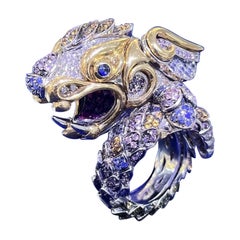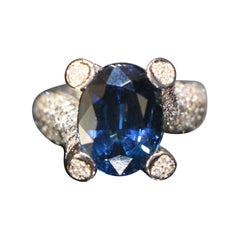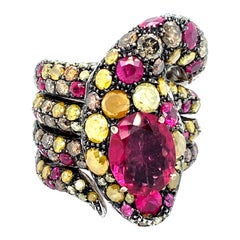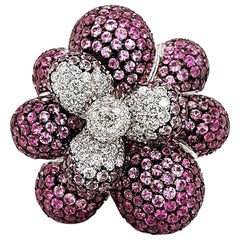Paolo Piovan Gioielli
| Styles |
| Related Creators |
18kt Gold Paolo Piovan Gioielli Precious Dragon Diamond & Sapphire Cocktail Ring
By Paolo Piovan Gioielli
Located in Boca Raton, FL
The 18kt Gold Paolo Piovan Gioielli Precious Dragon Diamond & Sapphire Cocktail Ring is a captivating work of art that blends bold design with exceptional craftsmanship. This strikin...
Category
21st Century and Contemporary Paolo Piovan Gioielli
Materials
Diamond, Sapphire, Gold
Gold ring with sapphire stone by the Italian brand Paolo Piovan Gioielli
By Paolo Piovan Gioielli
Located in Tel Aviv - Jaffa, IL
Gold ring embedded in the Italian brand Paolo Piovan Gioielli
The jewelry details:
Diamonds: White diamonds weighing 1.75 carats.
Central Gemstone: 7.15 carats Sapir Stone
Materi...
Category
2010s Italian Paolo Piovan Gioielli
Materials
Diamond, White Diamond, Sapphire, Gold, 18k Gold, White Gold
750 18kt solid white gold Paolo Piovan Gioielli Diamond Boa Ring
By Paolo Piovan Gioielli
Located in Antwerp, BE
750 18kt solid white gold Paolo Piovan Gioielli Diamond Boa Ring
Very precious and gorgeous Paolo Piovan Boa ring with open mouth set with rubies and diamonds, brilliant-cut diamonds of various yellow, orange and brown tints, signed P. Piovan, Italian maker's mark.
Diamonds: ca. 5,6 ct
Material: 750 18 kt solid white gold
Total weight: 40.0 gram
Ring size: 58 ( can be adjusted for free)
Padova, Italy–based Paolo Piovan Gioielli loves creatures large and small: alligators, scorpions, tigers, starfish, and sea anemone, but the design house particularly likes snakes. Consider several of its most recently made and dramatic styles: an icy diamond Cobra ring...
Category
21st Century and Contemporary Italian Artist Paolo Piovan Gioielli
Materials
Diamond, Ruby, 18k Gold
18kt white gold Cocktail Ring, Paolo Piovan Jewelry Sapphire Diamond
By Paolo Piovan Gioielli
Located in Antwerp, BE
18 kt white gold Cocktail Ring, Paolo Piovan Jewelry Sapphire Diamond
Stunning Paolo Piovan Jewelry exclusive sapphire and diamond rin...
Category
21st Century and Contemporary Modern Paolo Piovan Gioielli
Materials
Diamond, Sapphire, 18k Gold
18kt White Gold Paolo Piovan Cabro Bracelet Diamonds, Tsavorite, Ruby
By Paolo Piovan Gioielli
Located in Antwerp, BE
18kt White Gold Paolo Piovan Cabro Bracelet Diamonds, Tsavorite, Ruby,
Amazing, original Paolo Piovan bracelet set with 10.94 carat Tsavorite, 17.03 carat round brilliant icy diamonds and 0.73 carat ruby stones.
Tsavorite: 10.94 carat
Diamonds: 17.03 carat
Ruby: 0.73 carat
Material: 18 kt white gold
Total weight: 102.1 gram
Size: Max length around the arm: 18 cm
To open the bracelet, you stretch the top of the bracelet open, so its easy adjustable and can fit easily each person
Can be bought together with the matching original ring.
Comes with Orologio certificate, Orologio 1...
Category
2010s Contemporary Paolo Piovan Gioielli
Materials
Diamond, Ruby, Tsavorite, 18k Gold, White Gold
Browse all Jewelry from Paolo Piovan Gioielli
Shop NowCreators Similar to Paolo Piovan Gioielli
Paolo Piovan Gioielli jewelry & watches for sale on 1stDibs.
Find a range of Paolo Piovan Gioielli jewelry & watches available on 1stDibs. Each of these unique items was designed with extraordinary care, often using gold. While looking for the most stylish antique or vintage Paolo Piovan Gioielli jewelry to pair with your ensemble, you’ll find that Paolo Piovan Gioielli diamond jewelry & watches, from our inventory of 6, can add a particularly distinctive touch to your look. We have 6 pieces in this collection as well as a number of other designs by this jeweler. While this collection reflects work that originated over various time periods, most of these items were designed during the 21st century and contemporary. If you’re looking for additional options, many customers also consider jewelry & watches by Aldo Garavelli, Valente Milano, and oromalia. Prices for Paolo Piovan Gioielli jewelry & watches can differ depending upon gemstone, time period and other attributes. On 1stDibs, the price for these items starts at $19,383 and tops out at $44,775, while pieces like these, on average, can sell for $27,073.




